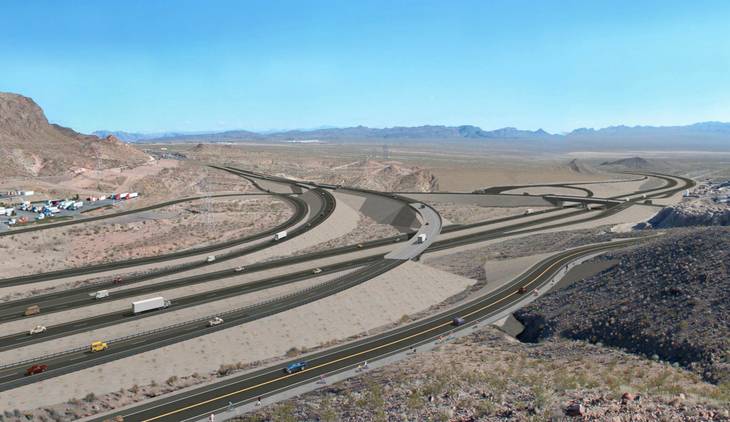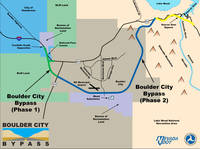Sun archives
- After I-15 work, freeway to Phoenix will become focus (7-13-2010)
- Engineering marvel taking shape near Hoover Dam (2-8-2010)
- Boulder City Council endorses Vegas-to-Phoenix interstate (8-12-2009)
- Freeway to Phoenix gains traction with bridge work (7-11-2009)
- Meeting planned to discuss changes to Boulder City Bypass (7-6-2009)
- Contractor selected for $270 million I-15 project (7-1-2009)
- A boost for DesertXpress (7-3-2009)
- Clark County roads wait for stimulus while rurals get work (6-10-2009)
- Declining gas tax revenue means fewer road projects (6-9-2009)
Sun Coverage
Developing an interstate highway from Southern Arizona to the Pacific Northwest is vital to keeping tourists and goods flowing through Las Vegas, transportation experts say.
Transportation consultant Tom Skancke and Regional Transportation Commission of Southern Nevada General Manager Jacob Snow on Tuesday gave the Las Vegas Convention and Visitors Authority board of directors long- and short-term needs assessments of regional transportation.
They said it’s time to urge federal lawmakers to get serious about the development of the proposed Interstate 11, a freeway that would link Southern Arizona with the Pacific Northwest through Las Vegas and Reno.
For the short-term, Snow said, the development of I-11 would be key to solving traffic snarls that have developed as a result of the opening of the new bridge over the Colorado River at Hoover Dam.
When the Mike O’Callaghan-Pat Tillman Memorial Bridge opened last fall, traffic slowed to a crawl through Boulder City as it encounters two lanes and lower speed limits between the Hacienda and the center of Boulder City.
The I-11 proposal includes a bypass of Boulder City around the southern end of town.
“When it first happened, we thought (the traffic jams) were an anomaly,” Snow said of the slow-downs through Boulder City. “But now, we’re seeing that it’s something that happens every weekend.”
Snow said a temporary solution is on the way when the Nevada Department of Transportation works on a $50 million widening of U.S. 93 between the Hacienda and Boulder City in July. But the time is right to gather congressional support for the designation of I-11 as a new interstate highway project, he said.
Delegations from Arizona, Nevada and Washington are on board, and there has been additional support from Oregon and California, because I-11 would relieve some of the north-south congestion that occurs on Interstate 5 through those states.
According to maps Snow showed board members, I-11 would roughly run northwest from Las Vegas along U.S. 95 toward Reno, Oregon and Washington, and southeast toward Phoenix along U.S. 93.
It would include Arizona’s planned Hassayampa Freeway south of Wickenburg and curve south and east around Phoenix, joining established freeways near Casa Grande.
Snow said the route is an important tourism corridor from Phoenix because 8.8 percent of Las Vegas visitors come from Arizona and 90 percent of them drive.
Tourists will also have to contend with more trucks transporting goods in the future as the route becomes more important to commerce.
Skancke noted that tourists and trucks share Interstate 15, the main route between Los Angeles and Las Vegas, as well as the key outbound route from Southern California seaports.
As China’s economy grows, more products will be transported inland from ports in Long Beach and Oakland, Calif.
Imports also will arrive at Punta Colonet, a new port that is a top development priority for Mexico, and I-11 would become an important route for goods into the United States.
Skancke said shipping to ports in California and Mexico is less expensive for China than transporting them through the Panama Canal to the East Coast because the trip takes less time.
The flow of commerce in the United States also will change as more coal is shipped to China. Skancke said highways and rail lines will move more coal from Wyoming mines to California and Mexican ports along I-15 and the future I-11.
Skancke is urging the continued development of highway improvements and rail lines to move goods and tourists.
He expects transportation demands to increase, with the U.S. Census Bureau forecasting Nevada’s population will grow by 116 percent in the next decade. Arizona, California, Utah and Colorado also anticipate double- and triple-digit percentage growth in the years ahead.
In addition to his support of the Western High Speed Rail Alliance and its plans to connect Las Vegas with Phoenix and Salt Lake City with high-speed passenger rail service, Skancke is supporting several highway projects, most of them in California, that would ease traffic between Los Angeles and Las Vegas.
His list of improvements include further work on the Devore interchange in San Bernardino, the connection of California Highway 91 and I-15 in Riverside, the High Desert Corridor between Victorville and Palmdale (which also would include right-of-way for high-speed rail to connect the DesertXpress project with the California high-speed train system), the I-15 weigh station at California Highway 138 and improvements in Nevada on I-15 south of Las Vegas.


